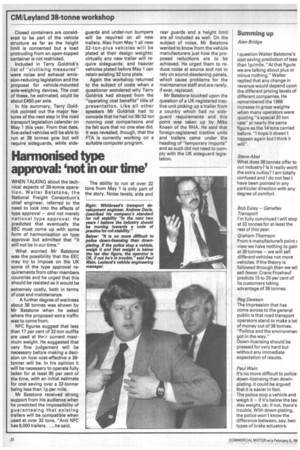Summing up
Page 24

If you've noticed an error in this article please click here to report it so we can fix it.
Alan Bridge I question Walter Batstone's cost saving prediction of less than 1p/mile. "At that figure we are talking about plus or minus nothing." Walter replied that any change in revenue would depend upon the different pricing levels of different companies. He remembered the 1968 increase in gross weights when many operators were quoting "a special 20 ton rate" at nearly the same figure as the 14 tons carried before. "I hope it doesn't happen again but I think it will".
Steve Abel What does 38 tonnes offer to our industry? Is it really word' the extra outlay? I am totally confused and I do not feel I have been pointed in any particular direction with any degree of comfort.
Bob Exley — Gene fax Transport I'm fully convinced I will stop at 32 tonnes for at least the rest of this year.
Graham Thomson From a manufacturer's point c view we have nothing to gain at 38 tonnes — we will sell differentvehicles not more vehicles. If the theory is followed through then we wil sell fewer. Crane Fruehauf predicts 15 to 20 per cent of its customers taking advantage of 38 tonnes.
Reg Dawson The impression that has come across to the general public is that road transport operators stand to make a lot of money out of 38 tonnes. "Politics and the environmen got in the way." Down-licensing should be pressed for very hard but without any immediate expectation of results.
Paul Wain It's no more difficult to police down-licensing than downplating. It could be argued that it is easier in fact.
The police stop a vehicle and weigh it — if it's below the tax disc weight, ok; if not, there's trouble. With down-plating, the police won't know the difference between, say, two types of brake actuators.












































































































